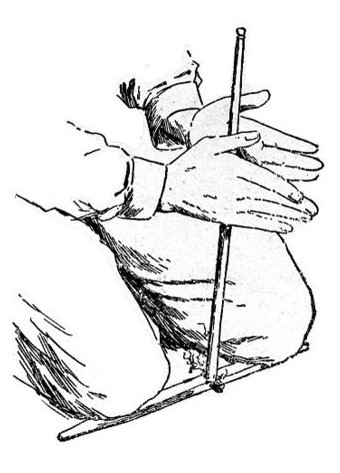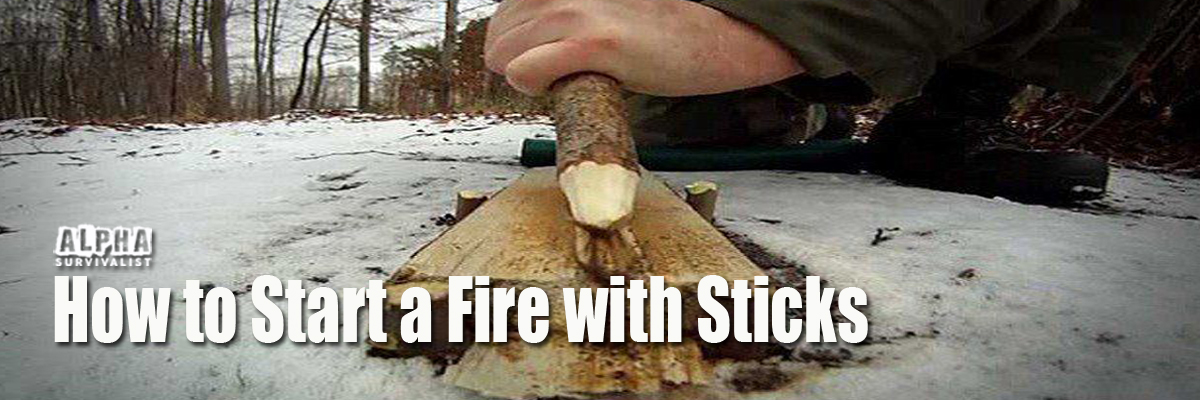
Would you still be able to start a fire?
If you thought it was as easy as rubbing two sticks together to instantly produce fire, then you’ve obviously been watching too many movies.
It takes a lot more effort to start a fire with sticks than what you may have been led to believe.
Anyone wanting to know how to start a fire with sticks will find that there are three basic ways of doing so:
- Using a Hand Drill
- With a Fire Plow
- Using a Bow Drill
As you might expect, each of these methods comes with its own unique set of challenges as well as advantages.
Each method has its pros and cons just like with anything else, so it’s important to have experience of all three.
This is especially true when you consider that even experienced bushmen can find it difficult to be successful every time using these very same methods.
While you might already be sold on the idea of learning how to start a fire with sticks, there are those who scoff at the idea. Those that do really ought to think again.
Having the ability to start a fire with what is lying around is one of the most important survival skills you are ever likely to learn.
Why You Ought to Learn How to Start a Fire With Sticks
Building a shelter and finding fresh water are always the first things that come to mind when people want to learn survival skills, and they’re usually a lot more lax about learning how to correctly build and start a fire.
Most preppers will possess one or more of the fire-starting items listed at the start of this post.
Many preppers might even stock boxes upon boxes of survival matches ready to strike whenever needed, providing the warmth and protection fire offers. Some may even make their own waterproof matches.
Unfortunately, all the convenient ways of starting a fire mentioned previously may not always be available. And even if they were, they will eventually run out or fail, no matter how impressive the stockpile.
Possessing fire making skills is extremely important.
The fact that things like lighters and matches can often get confiscated could leave you with only your bush craft knowledge to fall back on.
Whether it’s due to overactive TSA agents at the airport or an outrageous security rule of some kind, you might not have matches or a lighter on you when you need them the most.
Starting a fire with sticks might be the only method available to you if you ended up in that sort of situation.
To be blunt, you need to learn how to build a fire with sticks, even if you think it’s a skill you’ll never use.
All of the fire making methods mention previously, the hand drill etc, all rely on friction, so the basic technique you’ll be practicing is more or less universal.
However, the most important part of the whole process is learning which sticks to use!
Preparing to Start a Fire With Sticks
First off, you need to get the proper materials together for a fire.
Find a piece of dry flat wood to make a fire-board, which is also sometimes known as a hearth.
Don’t get confused, because while we use the word hearth to refer to something else today, this is just the name given to the underlying wood that’s going to help you start a fire.
You can set one up anywhere, including on bare ground without even the most basic of fire ring.
Assuming you found some dry flat wood, you’ll want to start gathering a collection of fine tinder (ideally you’ll have some char cloth, which is great for tinder, but most likely you won’t!). Look for dried leaves and small twigs. You need items that are going to go straight up in flames as soon as sparks touch them.
To recap, the basic steps when you’re gathering materials are as follows:
- Find a straight dry stick
- Find a dry flat piece of wood to serve as a fire board
- Gather a bundle of fine tinder
- Make kindling out of the materials you have on hand, such as extremely dry twigs that’ll ignite readily
- Provide a continual supply of dry wood as you build a fire.
Never select wood that has any significant amount of moisture in it, since this could put you at a serious disadvantage. Not only will your fire not burn as hot, but you’ll also run into difficulties starting a fire in the first place.
Wet wood can never build up nearly enough friction to start a fire the way that dry wood will.
Seasoned wood is of course preferred, but you’re not going to be able to find actual processed firewood in the wild so you’ll want to be able to pick out any wood that’s sufficiently dry.
Once you have gathered together everything you need, you’ll then need to start staging your kindling and tinder.
Staging Tinder for Starting a Fire with Sticks
When you’re starting a fire with sticks, you’ll need to be able to add more fuel constantly, so you’ll need to keep all of your tinder and kindling near you at all times.
If you have to go and look for a piece of kindling that you haven’t got to hand, then whatever small fire you may have started could easily go out whilst you’re doing so.
You need really dry and fine tinder to get the small embers given off by rubbing sticks together to actually become a fire. Bundle extremely fine dry plant material together and either leave it in a position where any falling embers from your sticks will ignite it, or cup your tinder in your hands and place the embers into the heart of it, blowing on it gently until the tinder ignites.
Once the fire gets a bit stronger, you can add more significant materials as kindling. Work your way up from smaller dry sticks until you get to the point where you can actually catch a small log or branch on fire.
Eventually, you’ll be able to add full-sized logs to build up a roaring fire, but you don’t want to skip any of the steps in the process.
Building up your fire too fast will actually risk putting it out. Large logs can suffocate embers and starve them of oxygen if added too soon. Adding pieces of cured wood, if you have any in your survival kit, are probably your best bet.
On top of this, you can use old stalks you collect as well as dried plants and dandelion fluff. Dry grass is one of your better bets, considering that it’s often the fuel that feeds many wildfires.
Generally, finer tinder tends to be more flammable, so don’t be afraid to use extremely small pieces you might have otherwise thought wouldn’t even burn.
Gather larger sticks or good solid twigs too, because you’ll need these to feed the tinder. Kindling should consist of wood that’s slightly larger and less fine than what’s found in your tinder bundle. Resin-filled dried soft woods like pine shavings are usually the best. Look for dry pine needles on the ground, since these usually burn fast.
You’ll often see dry cedar bark as a suggestion for what to use, but this is relatively uncommon in a lot of North American forests. European survivalists will want to keep an eye out for bits of larch trees, since these will normally light up quite fast as well.
Once you have all of your materials together, you’ll need to create an extremely high amount of friction using one of the three basic techniques for starting a fire with sticks.
Using a hand drill is the simplest but hardest method for beginners to learn and master, so we’ll start with that.
How to Start a Fire with Sticks – The Hand Drill

Start by sharpening the end of one sturdy stick down to a point. While it is possible to do this with rocks or even a harder piece of wood, it does help if you have a survival knife to hand.
Some survivalists will keep an old school hand pencil sharpener in their pack to run a dry stick in, which should make a really good point.
Regardless of how you get a sharp stick, you’ll need to put that honed end down on a fire board. Get a flat piece of wood, like a piece of long dried bark that looks about ready to go up in flames.
As you might have guessed, the drier the better.
Make a small notch in the fire board that your fire drill’s point can rest in.
Rest the pointed end of the stick in the small notch. Place your open hands at the top and on either side of the stick.
Make sure your palms are flat and then rub them together vigorously to make the stick spin whilst applying downward pressure at the same time.
This combo action of downward pressure and spinning creates a lot of friction at the contact point between the stick and the fire board.
You may need to place your foot down on the fire board to hold it steady while you’re spinning away as this can help to keep it from getting away from you.
While this is the simplest way to start a fire with a stick and a piece of wood, it could still take quite some time to create an ember you can use to start a fire.
Don’t give up!
It may be difficult but keep working at it, ensuring that you’re constantly pushing down in order to create the additional friction needed to produce an ember. Without that downward pressure, you’ll never be able to create embers.
When you see a little smoke, you’re on the right track. Keep drilling a little while longer and you’ll have yourself some glowing embers to work with.
Don’t waste time, once you have an ember you’ll need to quickly transfer it from the fire board to your tinder. Blowing gently on the ember whilst it sits in the middle of your tinder will help the tinder catch light.
Then it’s just a case of building up your fire, until you have a roaring camp fire on the go.
Unfortunately, pausing to rest too much during the drilling process makes it difficult to create enough heat through constant friction to create an ember.
Those who are lucky enough to have two people with them in this situation can trade off periodically, which could allow for a faster and more successful friction build-up.
If you find using a hand drill difficult or painful, then you may want to consider making a fire bow. A fire bow can certainly save your hands. However, this doesn’t mean you shouldn’t practice with a hand drill because the skills used to create an ember are the same skills used by those working with a bow.
The video below shows perfectly how a hand drill creates an ember for starting a fire.
How to Start a Fire with Sticks – The Fire Bow

Start by find a sturdy branch that has at least a little moisture to it. Try and find something that has a somewhat C-like shape to it, making it appear more like the way that an archery bow would look.
Though some people purchase commercially-manufactured fire bows, which are excellent by the way, and keep them in a supply kit, we’ll assume that you don’t have one in this case. If you had a kit with you, then there’s a good chance that you would have had some steel and flint to spark a fire instead of needing to resort to sticks anyway.
Take whatever twine you have on hand, even if it means taking a lace from one of your boots. Survivalists will sometimes keep a paracord bracelet with them so that they could convert it into a fire bow if they ever need to. In a worst case scenario, rip off a long strip of sturdy fabric from your outermost layer of clothing.
Tough and flexible vines, like those from wild grape plants, could also work. You want around 1½ times the length of the flexible piece of wood you’re going to use for a bow.
Attach the cord to each end of what will be your bow. Make sure that you attach them tightly, making certain they won’t come off while you’re using the bow.
You’ll need to find a piece of hard wood, a shell, or even a stone that has a recess, this will be used to apply downward pressure to drill. It also helps if you can find some kind of natural lubricant, a crushed slug maybe, or some damp, fresh leaves, can work quite well too. Once again you’ll need a sturdy dry stick that you’ve sharpened, just like we covered in the hand drill explanation above and a fire board.
Loop the cord once around and put the drill down into the fire board recess. Steady the drill by pressing down on the top of it with your other hand using the lubricated hardwood or stone. This will help to keep the drill and bow from moving all over the place and provide the downward pressure needed to increase the friction.
Start to move the bow back and forth like you’re sawing. It can be a little difficult to get the motion down at first and you’ll probably slip off the fire board once or twice, so you might want to make your notch on the fire board a little deeper.
While it may take just as long as using a hand fire drill to create your ember, it should be easier on your hands and you can produce a lot of pressure more easily than you could with just a hand drill. It also can help to reduce the risk that your sticks will break in the process, which is a real problem when you’re starting a fire with sticks from any species of tree that isn’t really tough.
Once you have your ember and you’ve used it to ignite your tinder, you’ll need to build a fire the same way you would have if you generated embers any other way.
The video below shows how to make and use a fire-bow to start a fire.
How to Start a Fire with Sticks – The Fire Plow

You create a trough in your fire board that’s far more significant than the notch that you’d need to when making a hand drill or fire bow.
Once again, it would be ideal if you had a survival knife or another type of cutting tool to carve out a trough. If not you could utilize the sharp edge of a rock or any piece of sharp debris you might be able to find. Once you have your piece of wood with a newly gouged out trough you’re ready to start making fire.
Place the tip of a stick, which again needs to be honed to a point, down into this trough and vigorously push and pull the tip into it at a 45° angle.
Continue to use enough pressure to slide the stick along the trough in a very quick manner. Eventually, you’ll get to a point where it becomes easier, in which case you’ll want to increase the amount of pressure that you’re using with each stroke. While it could take quite a while for this to produce results, you will eventually build up some hot embers.
Those in western states may find that Yucca plants are particularly useful for starting a fire using this kind of methodology. Otherwise, though, you could theoretically use any type of sufficiently dry material that you could push and pull the tip of a stick through. It helps if you can find something that’s extremely dry to the point of nearly cracking.
That being said, it also has to be sturdy enough that it will indeed hold up through the entire process of you doing this.
Once you have your embers continue to make a fire in the same way as with the two previous methods.
The Importance of Practice when Starting a Fire with Sticks
Despite the fact that it probably still seems at least somewhat easy to do this, it isn’t. The techniques themselves aren’t difficult and they might not even take that much practice to completely master. However, what you do need to practice is the perseverance to see the process all the way through sparking a fire.
Moreover, you need to build up endurance so that you can rub sticks together long enough without doing any damage to your wrists.
Try finding a place like a fire ring or pit where it’s safe to practice and gather some materials. While you might want to start by using a commercially available fire bow or plow, you’ll certainly want to try making your own once you have the skills to do so. Try starting a fire with sticks that you just find lying around.
Naturally, you wouldn’t be able to get to a store in the case of a real emergency, so it’s important to also learn how to gather materials and make your own fire.
Though it could take a while, putting your mind to it now can pay off big dividends later on if you ever really did need to use these skills. While learning how to start a fire with sticks shouldn’t take too long in theory, practice makes perfect so you might want to plan regular drills just to keep in practice.

